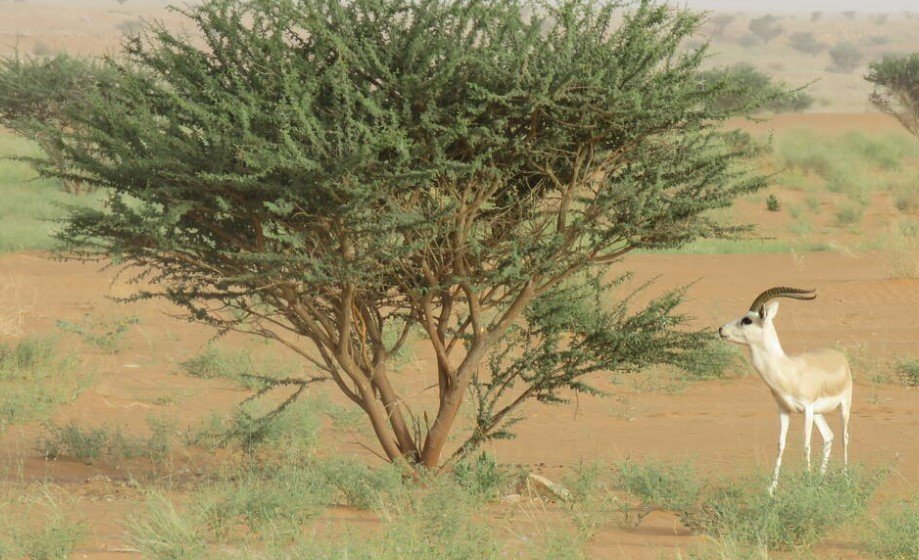Saudi Arabia has landed another environmental win. Uruq Bani Ma’arid—an epic sprawl of desert life on the fringe of the Rub’ al Khali—has officially been added to the IUCN Green List. It’s a global stamp of approval that quietly speaks volumes.
It’s more than just a label. This is Saudi Arabia signaling, again, that it’s dead serious about protecting some of the most fragile habitats on Earth—and that deserts, too, deserve a spot on the map of world-class conservation.
Where Sand Meets Science and Survival
Uruq Bani Ma’arid isn’t just a sea of dunes. It’s a living archive of nature’s resilience.
Located along the western edge of the Empty Quarter, the protected area sprawls across 1.27 million hectares of one of the planet’s harshest ecosystems. Here, sand gives way to the dramatic rise of the Tuwaiq escarpment, and dry riverbeds—called wadis—breathe life into the terrain when the rare rains fall.
This rugged sanctuary is now part of the IUCN’s Green List—the gold standard for well-managed, biodiverse, and community-conscious protected areas.
And it didn’t get there by chance.

A Checklist That’s Anything But Simple
To earn its place, Uruq Bani Ma’arid had to hit a strict set of criteria laid down by the International Union for Conservation of Nature.
That includes:
-
Demonstrated biodiversity conservation outcomes
-
Transparent governance practices
-
Deep engagement with local communities
-
Long-term planning and effective monitoring
According to officials, it checked all the boxes through years of painstaking groundwork—ecological surveys, wildlife monitoring, and a clear roadmap for how to preserve what’s left while restoring what’s been lost.
And it’s not just a win for paperwork. It’s a win for wildlife.
A Desert Refuge for the Arabian Oryx
One of the most powerful symbols of the reserve’s success? The Arabian oryx.
Once completely wiped out in the wild, the slender, white antelope with long, straight horns now thrives in Uruq Bani Ma’arid. Breeding and reintroduction programs run by the National Center for Wildlife have brought the species back from the brink.
Now, nearly 20% of the global population lives inside the reserve.
That’s a big number. And it’s not the only species benefitting. The site also shelters sand gazelles, foxes, and dozens of bird species adapted to the desert’s extremes.
It’s a reminder that even in places that seem empty, life fights hard to exist.
Third Time’s a Charm for Saudi’s Green List Ambitions
Uruq Bani Ma’arid isn’t Saudi Arabia’s first protected area to make the Green List. It’s the third.
The Ibex Protected Area and the King Salman bin Abdulaziz Royal Reserve joined the list earlier, carving out Saudi’s growing role in a global conservation movement.
But Uruq Bani Ma’arid stands apart in scale and symbolism. It’s the first UNESCO World Heritage Site in the country to achieve this environmental recognition too.
So now it holds dual status: celebrated for its natural beauty and respected for its ecological stewardship.
Not bad for a place that most maps show as just sand.
A Table That Says It All
Here’s how Uruq Bani Ma’arid stacks up compared to other Saudi sites on the Green List:
| Protected Area | Year Inscribed | Total Area (Hectares) | IUCN Green List | UNESCO World Heritage |
|---|---|---|---|---|
| Uruq Bani Ma’arid | 2025 | 1,270,000 | ✅ | ✅ |
| Ibex Protected Area | 2023 | 1,230 | ✅ | ❌ |
| King Salman bin Abdulaziz Royal Reserve | 2024 | 130,700 | ✅ | ❌ |
It’s clear which one carries the heaviest environmental clout.
Science, Strategy, and a Bit of Grit
The work behind the scenes wasn’t glamorous, but it was critical.
Scientists mapped habitats. Rangers tracked oryx and sand gazelles. Conservationists rolled out sustainable grazing plans and monitored invasive plant species. And they kept going—even when the heat and sandstorms didn’t make it easy.
One-sentence moment: It’s desert conservation, Saudi-style.
The National Center for Wildlife’s strategy focuses not just on fencing off land, but actively managing it—fixing what’s broken, rewilding what’s gone, and adapting with the times.
What the Green List Really Means on the Ground
Okay, so what does this actually change?
For starters, it gives Saudi conservation efforts credibility on a global stage. But maybe more importantly, it gives local communities—and the broader Gulf region—a tangible example that conservation isn’t just talk.
It’s action. Long-term, accountable, measurable action.
And maybe it makes a kid growing up in Riyadh today think of the desert not just as a backdrop, but as a place worth protecting.
